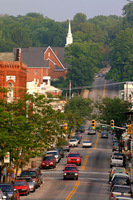
Lewisburg, once voted America’s “coolest small town,” has a lively arts community, thriving and varied commerce, and a high quality of life.
At an elevation of 2,300 feet, the seat of Greenbrier County has long been a refuge from East Coast summer heat and humidity. The climate and numerous natural springs have brought visitors to the area since the pre-Colonial era. The town is situated at what was once the crossing of the Seneca and Midland trails, which now are incorporated into U.S. 219 and U.S. 60. Interstate 64 also passes near Lewisburg and nearby White Sulphur Springs, home of the Greenbrier, whose clientele keeps many upscale Lewisburg antique shops, art galleries, and restaurants in business. Every summer the West Virginia State Fair in neighboring Fairlea also brings an influx of traffic.
Lewisburg is unusually bustling for a town of 3,830 residents. There are dozens of clothing stores, gift shops, pubs, coffee and sandwich shops, bakeries, and places for a more refined meal. One of the most unusual places to eat is the General Lewis Inn, a bed and breakfast whose dining room is open to the public. The Inn was built in 1834 as the home of John Withrow. The lobby was added with the west wing in 1928 and features a collection of antiques.
The Virginia General Assembly officially established Lewisburg in 1782. A 236-acre National Register Historic District showcases buildings from the town’s rich history that escaped an August 1897 fire, which burned most of downtown. Brochures for a walking tour of the downtown district can be picked up at the Greenbrier County Visitor’s Center or at many downtown locations. The Maple Street Historic District, located north of the Greenbrier County Library, features homes and businesses in the town’s historically African-American neighborhood.
Lewisburg’s Andrew Lewis Park is named after General Andrew Lewis, who first camped there with his father, John, and brother, Thomas, in 1751 while John Lewis surveyed the area. In 1774 Andrew Lewis assembled more than 1,000 frontier militiamen at the site before marching to Point Pleasant to fight Chief Cornstalk. The park includes Lewisburg’s original spring, Lewis Spring.
North House Museum, a home dating from 1820, houses the Greenbrier Historical Society. Among its artifacts are items from the Civil War, period furniture, and historic wagons. Lewisburg was the site of a major battle between the North and the South on May 23, 1862, that included a future U.S. president, then-Union Major Rutherford B. Hayes. The city’s Confederate Cemetery on McElhenney Road holds the remains of 95 Confederate soldiers.
The historic district includes the Old Stone Presbyterian Church, which was built in 1796 and is the oldest church in continuous use west of the Allegheny Mountains. John Wesley United Methodist Church, built in 1835, features interior galleries and a slave entrance. Visitors can see where a cannonball hit the southwest corner of the building during the Battle of Lewisburg in 1862.
The town has long been a center of law and education. In 1831 the Virginia Supreme Court began meeting regularly in Lewisburg. The current county courthouse is the oldest in continuous operation in West Virginia. The West Virginia School of Osteopathic Medicine was established in 1974 at the former Greenbrier Military School (1812-1972), and the Greenbrier Military School Museum is located next to the osteopathic school alumni center. The Greenbrier River Branch of the New River Community and Technical College and Carnegie Hall are situated on the grounds of the former Greenbrier College for Women.
Carnegie Hall was built in 1902 by steel baron and philanthropist Andrew Carnegie as a classroom building for the Lewisburg Female Institute, later called the Greenbrier College for Women. Now a regional not-for-profit arts and education center, it is one of four Carnegie Halls still in continuous use in the world and has year-round live performances and art exhibits.
Carnegie Hall is only one of several performing arts venues in Lewisburg. The Greenbrier Valley Theatre offers year-round live performances in a building that once held Leggett’s Department Store. The Trillium Performing Arts Collective is a community organization and school.
There also is much to see and do near Lewisburg. Lost World Caverns is a designated a National Natural Landmark with a subterranean rock mountain and a prehistoric ocean floor. Organ Cave has 45 miles of mapped passageways. Greenbrier County has several golf courses and fly fishing streams; the 164-acre Lake Sherwood has boating, swimming, fishing and camping; the 5,100-acre Greenbrier State Forest has cabins, camping, hiking, swimming and hunting; and the 77-mile Greenbrier River Trail provides river access for fishing and canoeing and is used for hiking, biking, and cross-country skiing.
Written by Jennifer Bundy
View SeeWV Lewisburg in a larger map

